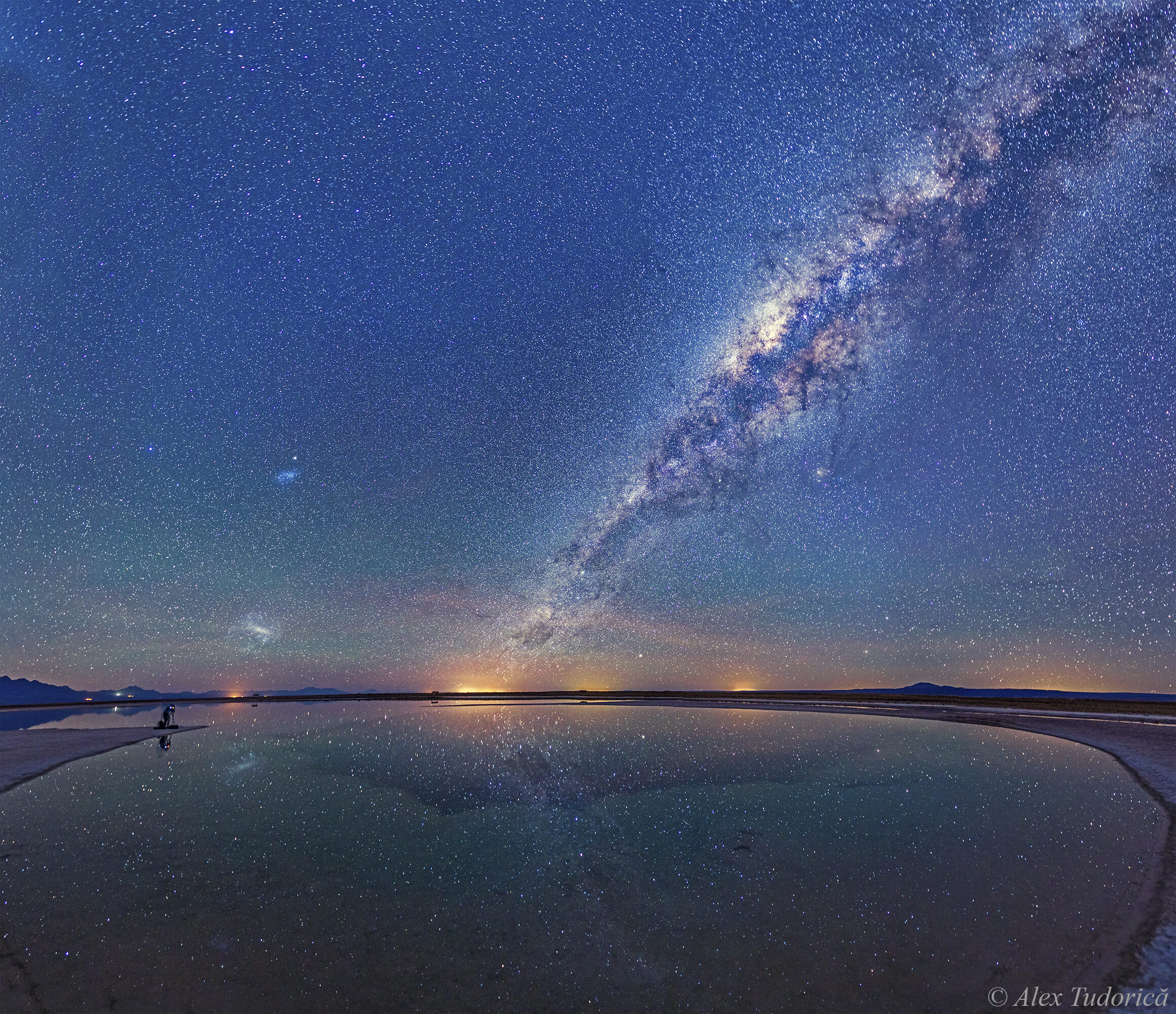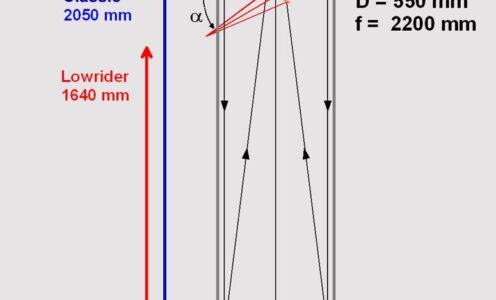<<<<The string concept
Lowrider
Just like the string concept, the lowrider[1] concept was conceived by an American, Ed Taychert. He first experimented with this concept on an 18 inch telescope. In 2001 he presented his 20 inch f4.4 Dobson telescope at the 2001 Stellafane Convention of Amateur Telescope Makers[2]. This telescope had a secondary mirror that was tilted less than 45°. The focuser was placed under the secondary ring. This way one could observe the entire sky without using a ladder.
Figures 6[3] visualizes the concept. In a normal Newtonian telescope the secondary mirror is placed at 45° angle. To create a lowrider the secondary is tilted downward α degrees and the focuser placed lower on the telescope and also tilted α degrees. In figure 6 (first image) the eyepiece height of a 22 inch f4 is reduced by 410 mm by tilting the secondary mirror 30° from its original position.
Note that because the distance a (see figure 6, second image) between the secondary mirror and the focuser is also increased, the secondary not only tilts as compared to its original position but also moves downward. Because of this increase in distance a, the secondary mirror needs to be slightly larger than in a normal Newton telescope. In this example an α of 30° raised the obstruction of the secondary to 25%. This is only just acceptable and for this reason an α of more than 30° would be ill-advised. There is also the question of baffling. Blocking stray light becomes increasingly difficult if a high α is used.
Figure 6


To calculate the position of the secondary, focuser and eyepiece I used Sketchup. The advantage of this was that I could put a human model of my size next to the telescope to see what the effect of a different α would be. A much simpler, but equally effective way of calculating the positions is by drawing in 2D. In figure 6 the distance a between the focal plane (in green) and the secondary mirror should be large enough to accommodate the focuser, focus travel and a focuser baffle. This distance can be calculated by first establishing distance c, which is the distance from the center of the light path of the telescope to the edge of the light path. It can be calculated using the formula:
2 * c = D + sin(ϕ)F
In which:
D = the diameter of the primary mirror; F = the focal length of the primary mirror; ϕ = maximum angular field of view. When we set the value for ϕ at 1/2°[4], the formula can be simplified to:
2 * c = D + F/100
b and a can now be calculated using basic goniometric formulas; tan α = b/c and cos α = c/a
These values can also be obtained from a drawing. The distance between the eyepiece and the primary mirror is f–a–b, where f is the focal length of the primary mirror. The eyepiece position above the ground is obtained by adding the distance from the primary to the ground.
Advantages
The obvious advantage is lowering the eyepiece height of a telescope. The eyepiece height usually becomes an issue[5] with a telescope that is larger than 16 inch. Another advantage is that it eliminates the need for a fast mirror, which has several extra benefits. Firstly, fast mirrors are more expensive than slow mirrors. An f5 mirror can be 30 percent cheaper than an f3.6. Furthermore, it is easier to buy a good mirror simply because making a good f5 mirror is much easier that making a good f3.6. This also means that building a “lowrider” makes it possible to grind your own mirror. Grinding a large f5 mirror is feasible for most experienced ATMers, whereas grinding an f3.6 is extremely difficult. A slower mirror also negates the necessity of a coma corrector. Lastly, it is easier to get good collimation with a slower telescope.
Unlike the string concept, Ed Taychert’s innovative lowrider concept was not widely adopted by the ATM community in the United States in telescopes up to 25 inch. In bigger telescopes there are a few example to be found. Surprisingly, the German ATM community seemed to be the early adapters of this idea. With a lot lowriders being successfully constructed by German ATMers. The lack of interest by ATMers in the US is probably because at time the idea of a lowrider got traction in the community, faster mirrors started to become more available at reasonable prices in the US. Though these mirrors are still a little more expensive and not easily homemade,for the US market, this most likely prevented widespread adaption among ATMers..
Drawbacks
There are of course some drawbacks to the concept. More care needs to be taken to ensure good baffling. A focuser baffle is really essential. Most ATMers building lowriders make baffles on top of the secondary mirror holder. This is an effective way of shielding the upper part of the view from your focuser and eliminates the need for a large shield on the outside of the secondary ring. However, this can create vibrations, disturbing the image and is something to take in account when designing the secondary ring.
A further downside is the need for a slightly bigger secondary mirror. This difference relatively small because a f3.6 telescope also needs a bigger secondary mirror than a traditional f5 telescope.
Then there is the unusual eyepiece position of a lowrider. The head of the observer is also tilted α degrees when looking at the zenith. The angle becomes less pronounced as the observer looks at object on a lower altitude, and is 0° when looking at the horizon. Personally, I have not experienced observing with a lowrider telescope as more tiring or straining than with my previous telescopes.
>>>>The Secondary & Mirror box
[1] The origin of the term “lowrider” is unknown, but is widely used by German ATMers
[2] http://stellafane.org/convention/2001/2001-scopes.html
[3] Courtesy of Reiner Vogel
[4] Kriege & Berry, The Dobsonian Telescope, page 152
[5] Depending on the size of the observer


